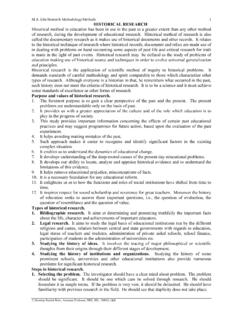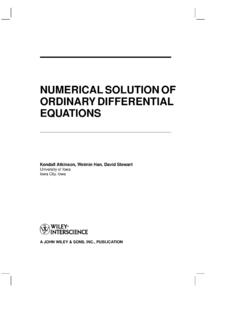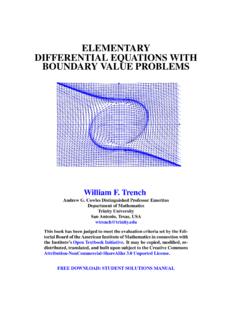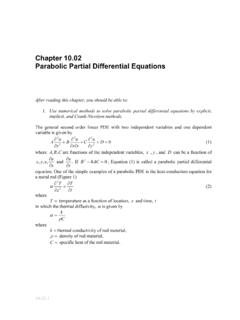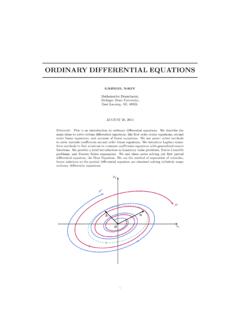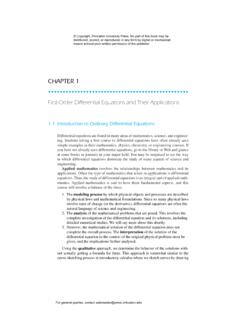Transcription of Chapter 2 PARTIAL DIFFERENTIAL EQUATIONS OF SECOND …
1 Draft PDE Lecture Notes Khanday Department of Mathematics, University of Kashmir, Srinagar-190006 1 Chapter 2 PARTIAL DIFFERENTIAL EQUATIONS OF SECOND order INTRODUCTION: An equation is said to be of order two, if it involves at least one of the DIFFERENTIAL coefficients r = ( 2z / 2x), s = ( 2z / x y), t =( 2z / 2y), but now of higher order ; the quantities p and q may also enter into the equation. Thus the general form of a SECOND order PARTIAL DIFFERENTIAL equation is ( , , , , , , , ) =0 ..(1) The most general linear PARTIAL DIFFERENTIAL equation of order two in two independent variables x and y with variable coefficients is of the form + + + + + = ..(2) where , , , , , , are functions of and only and not all , , are zero.
2 : Solve = 6 . Sol. The given equation can be written as 2 2 = 6 ..(1) Integrating (1) w. r. t. = 3 2 + 1( ) ..(2) where 1( ) is an arbitrary function of . Integrating (2) w. r. t. we get = 3 + 1( ) + 2( ) where 2(y) is an arbitrary function of y. = Sol: Given equation can be written as 2 2=1 ..(1) Integrating (1) w. r. t., , we get = 22 + 1(y) ..(2) where 1(y) is an arbitrary function of y Integrating (2) w. r. t., x, z = 36 + x 1(y) + 2(y) Draft PDE Lecture Notes Khanday Department of Mathematics, University of Kashmir, Srinagar-190006 2 or z = 2 + x 1(y) + 2(y) where 2(y) is an arbitrary function of y. : Solve r = 2y2 Sol: Try yourself. Ex. 4. Solve =sin( ) Sol.
3 Given equation can be written as 2 2 =sin( )..(1) Integrating (1) w. r. t., y = 1 cos( ) + 1( ) ..(2) Integrating (2) w. r. t., y = 1 2 sin + 1 + 2 which is the required solution, 1, 2 being arbitrary functions. Exercises: =1 Sol: We know that = 2 Therefore 2 =1 or 2 =1 Integrating , y we have =1 log + Again integrating , x we get =log log + + 0r =log log + + Draft PDE Lecture Notes Khanday Department of Mathematics, University of Kashmir, Srinagar-190006 3 Exercises:2 +2 = Sol: The given equation can be written as 2 =2 +2 Integrating , , we have = 2+2 + Integrating , , we have = 2 + 2 + + = 2 + 2 + + Exercises: + =9 2 3 Sol: The given equation can be written as 2 2+ =9 2 3 + =9 2 3 + =9 3.
4 (1) which is linear first order DIFFERENTIAL equation in I. F. is log = Multiplying (1) by we get + =9 2 3 =9 2 3 =9 3 33+ =3 3 3+ Draft PDE Lecture Notes Khanday Department of Mathematics, University of Kashmir, Srinagar-190006 4 =3 3 3+ =3 2 3+ Integrating with respect to we get = 3 3+ log + Exercises: = Sol: Please try yourself. Exercises: = 2 Sol: Please try yourself. Exercises: =2 2 Sol: The given equation can be written as 2 2=2 2 =2 2 Integrating with respect to we get =2 2 + =2 2 + Integrating we get = 2 2+ + = 2 2+ + Exercises: =sin Sol: Please try yourself. Exercises:log = + Sol: The given equation can be written as Draft PDE Lecture Notes Khanday Department of Mathematics, University of Kashmir, Srinagar-190006 5 log = + = + = Integrating we get = + = + Integrating , , we get = + + or = + + Exercises: = 2 Sol: Please try yourself.
5 Exercises: + + =0 Sol: The given equation can be written as + + =0 Integrating with respect to , we get + + = + = It is of the form + = Its auxiliary system is 1= 1= ..(1) From first two fractions of (1) we get Draft PDE Lecture Notes Khanday Department of Mathematics, University of Kashmir, Srinagar-190006 6 = = From first and third fractions of (1) we get 1= = = = It is first order linear DIFFERENTIAL equation in Its integrating factor is = Therefore = = + Exercise: + + =1 Sol: Please try yourself. Exercise: Find the surface passing through the parabolas, 2=4 , =0 and 2= 4 , =1 and satisfying the equation +2 =0. Sol: The given SECOND order PARTIAL DIFFERENTIAL equation is +2 =0 +2 =0.
6 (1) It is first order linear DIFFERENTIAL equation in . Its integrating factor is 2 = 2log = log 2= 2 Draft PDE Lecture Notes Khanday Department of Mathematics, University of Kashmir, Srinagar-190006 7 From (1) we get 2 = 0 2 = 0 + ( ) = ( ) 2 Integrating w. r. t. we have = 1 + .. (2) Using the given condition =0, = 24 , in equation (2), we have 0= 4 2 + or =4 2 .. (3) Also for =1, and = 24 , we have from (2) we have 1=4 2 + Using (3) we get or 1=4 2+4 2 1=8 2 = 28 Substituting , in (3) =4 2 28 =12 Draft PDE Lecture Notes Khanday Department of Mathematics, University of Kashmir, Srinagar-190006 8 Therefore from (1) we get = 28 +12 Which is the required surface passing through the parabolas.
7 Exercise: Find the surface satisfying =6 3 containing the two lines =0= and =1= Sol: The given 2nd order PDE is =6 3 =6 3 Integrating w. r. t., , we have =6 3 22+ =3 3 2+ Integrating w. r. t., , =3 3 33+ + = 3 3+ + ..(1) Using given conditions =0= , in (1), we have 0=0+0+ =0 .. (2) Also using =1= in equation (1) we get, 1= 3+ + Using (2), we get 1= 3+ +0 =1 3 ..(3) Using (2) and (3) in (1) we get Draft PDE Lecture Notes Khanday Department of Mathematics, University of Kashmir, Srinagar-190006 9 = 3 3+ 1 3 Which is the required surface containing the two lines. Exercise: Find the surface satisfying + =0, and touching the elliptic paraboloid =4 2+ 2 along the surface of plane =2 +1.
8 Sol: From the given equation we have + =0. Integrating with respect to , we have + = Now, the auxiliary system is 1= 1= ..(1) Taking first two fractions we get 1= 1 Integrating we get = + = ..(2) Also from 2nd and 3rd fractions of (1), we get 1= = = + or = + = + .. (3) From (3), we get = = ..(4) q= = .. (5) Draft PDE Lecture Notes Khanday Department of Mathematics, University of Kashmir, Srinagar-190006 10 Since =4 2+ 2 = =8 ..(6) & q= =2 ..(7) From (4) and (6) =8 .. (8) From (5) and (7) =2 .. (9) Adding (8) and (9) we get =8 +2 =82 1 +2 =6 4 Integrating w.
9 R. t., , we get =3 2 4 + .. (10) Also, from (8) =8 = 8 1 = 8 +1 Integrating w. r. t., we get =4 2+8 + .. (11) Substituting (10) and (11) in (3) we get =3 2 4 + 4 2 8 + = 4 2 2+4 8 +8 + From the given condition, 4 2+ 2 +1 2= 4 2 2 +1 2+4 2 +1 8 +8 2 +1 + 8 2+2 2 +1 2=4 2 +1 8 +8 2 +1 + 8 2+8 2+2+8 =8 +4 8 +16 2+8 + Draft PDE Lecture Notes Khanday Department of Mathematics, University of Kashmir, Srinagar-190006 11 = 2 Therefore = 4 2 2+4 8 +8 2 which is required surface. Exercise: Show that the surface satisfying =6 +2 and touching = 3+ 3 along its section by the plane + +1=0 is = 3+ 3+ + +1 2. Sol: Try yourself. PARTIAL DIFFERENTIAL EQUATIONS with constant coefficients: We know that the general form of a linear PARTIAL DIFFERENTIAL equation + 1 1 + 2 2 2+ + 1 =.
10 (1) Where the coefficients , 1, 2, .. , 1 are constants or functions of and . If , 1, 2, .. , 1 are all constants, then (1) is called a linear PARTIAL DIFFERENTIAL equation with constant coefficients. We denote and by and respectively. Therefore (1) can be written as + 1 1 + 2 2 2+ .. + 1 = , .. (2) or , = , The complementary function of (2) is given by + 1 1 + 2 2 2+ + 1 =0 ..(3) or , =0 Let = + be the part of the solution = = + 2 = 2 2= 2 + .. Draft PDE Lecture Notes Khanday Department of Mathematics, University of Kashmir, Srinagar-190006 12 = = + And = = + 2 = 2 2= +.

